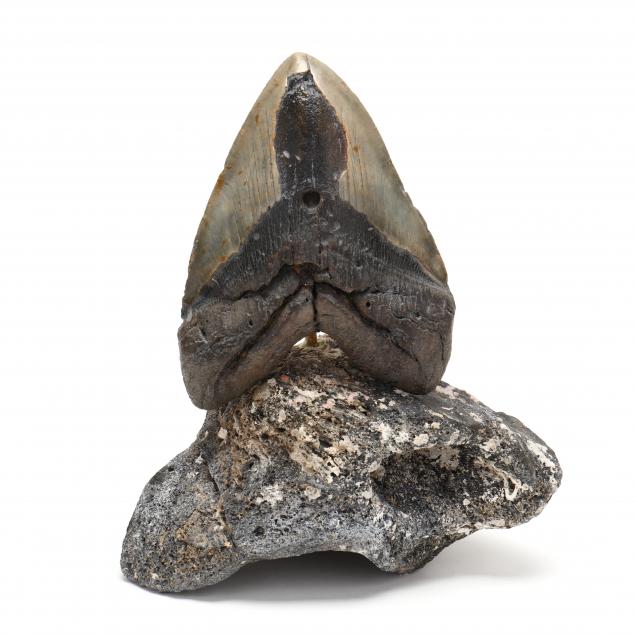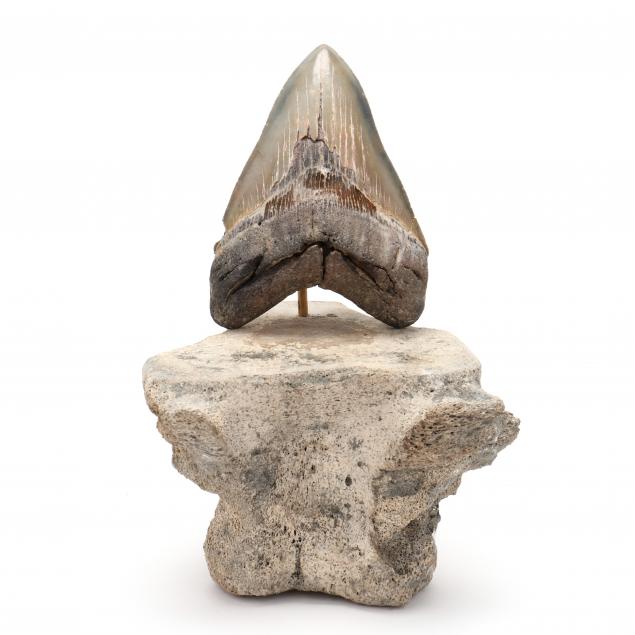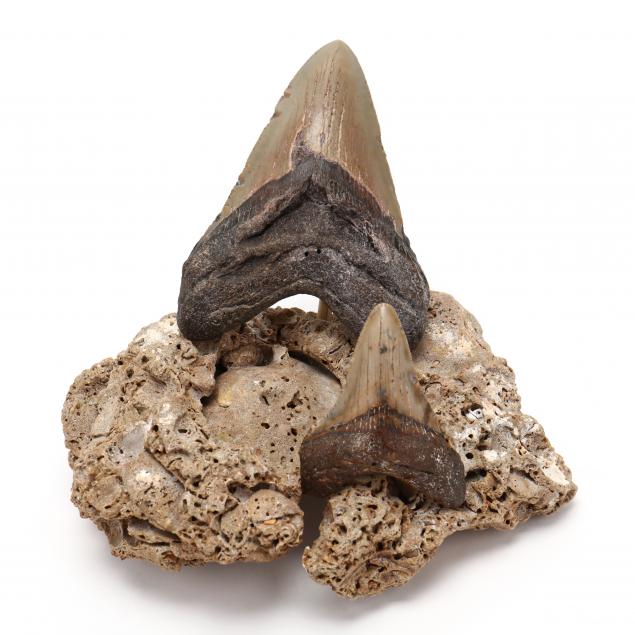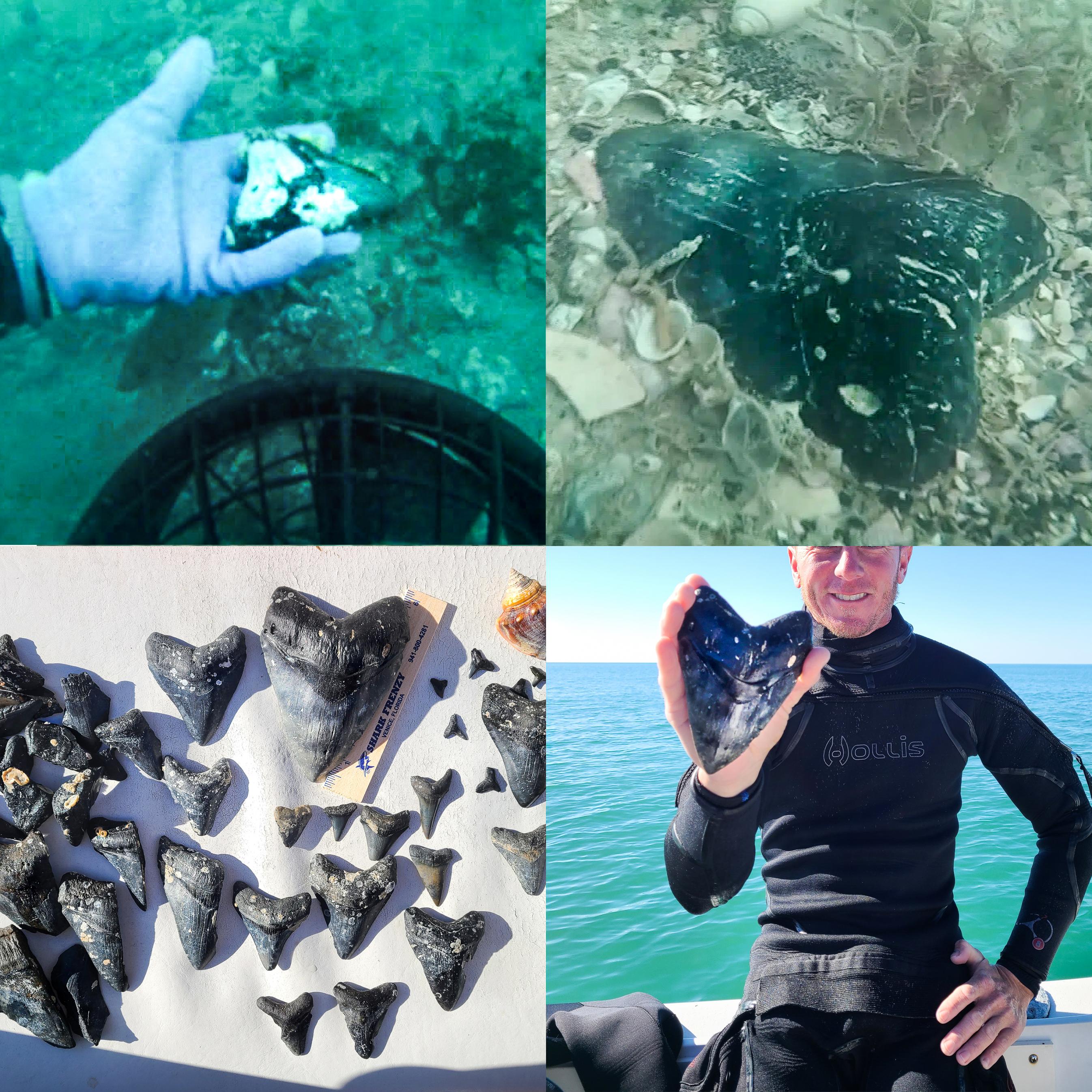
Photographs sourced from Michael Nastasio of Black Gold Fossil Charters
On The Hunt
The world turns, the millennia pass, and the hunter becomes the hunted. But possibly not until the hunter is long-extinct and thoroughly fossilized. Robert E. Wilke, who spends his leisure time at the bottom of the ocean, hunting for Megalodon teeth, has reason to be glad for that reliable passage of time.
Otodus megalodon, the largest shark to ever have lived, dates back 20 million years. These giant apex predators, which have been extinct for at least 3.6 million years, were three times longer than the biggest great white shark on record. With their giant teeth, Megalodon ate dolphins, whales, and other sharks. Modern-day sharks lose an entire set of teeth every week or two, going through around 40,000 teeth in their lifetimes. Which means that, if Megalodon teeth functioned similarly to their descendants', the ocean floor is, well, a veritable ocean of Megalodon teeth, 16 million years in the making.
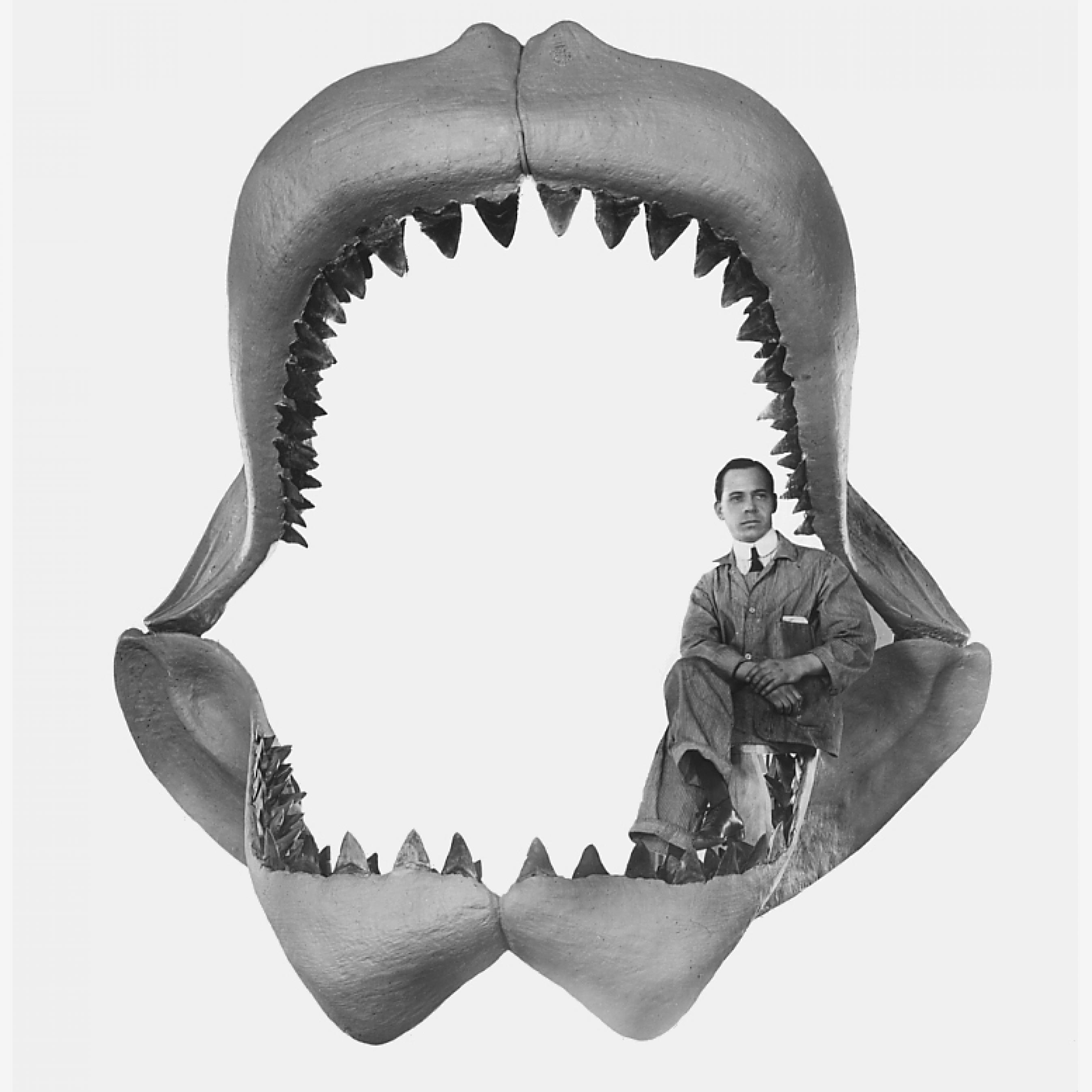
A 1909 Megalodon jaw reconstruction
Megalodon teeth have been found off the coast of every continent other than Antarctica. But the coast of the Carolinas and Florida have been particularly fruitful for Meg tooth hunters. Fossilized teeth have even been found in the intercostal waterways and saltwater streams of the region. Megalodon stayed in warmer waters when young, and likely had their pups near the shore. Some connect their extinction to the global cooling that happened 2.6 million years ago.
For Wilke, the hero of our story, the Meg's predilection for slightly warmer water means happy hunting in the downtime from his day job as a US NAVY / Marine Corps AirSpace coordinator in North Carolina. Wilke has been tracking down historic relics for decades, and sometimes consigns the Megalodon teeth he finds to auction. Happily for us, Wilke was willing to answer our questions about tooth-hunting, so that we can dive vicariously, without actually having to suit up and submerge the necessary 100+ feet below the surface of the ocean.
LLA: How'd you get into diving?
RW: I started diving in Okinawa, Japan in 2002 while I was in the Marines there - I wanted to locate WW2 relics offshore.
LLA: Did you start finding Megalodon teeth just because you enjoyed the diving or do you dive specifically to find the teeth?
RW: I never dive for fun - it's a little dangerous and a pain in the butt to do. But if there are artifacts, I’m in!
RW: I started diving in Okinawa, Japan in 2002 while I was in the Marines there - I wanted to locate WW2 relics offshore.
LLA: Did you start finding Megalodon teeth just because you enjoyed the diving or do you dive specifically to find the teeth?
RW: I never dive for fun - it's a little dangerous and a pain in the butt to do. But if there are artifacts, I’m in!
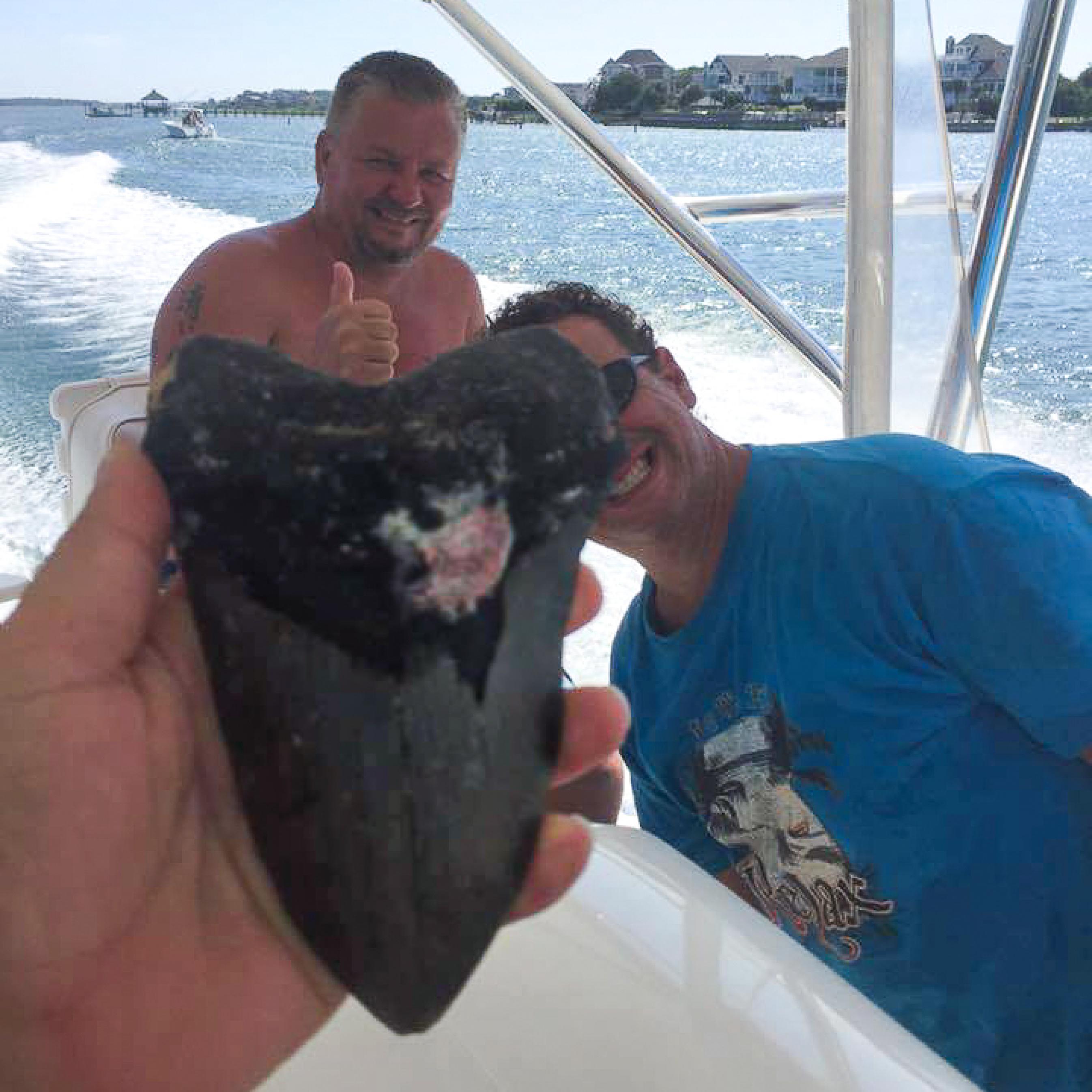
Robert E. Wilke on a Meg tooth dive
LLA: How often do you dive and where?
RW: Nowadays I'm strictly diving on the Meg Ledges 40+ miles off the coast of North Carolina, in the vicinity of Frying Pan Tower. I did a few years of river diving 10 years ago or so, but that is dangerous work, mainly due to strong currents and lack of vision. So far this year I have been out twice and have been “blown out” due to sea conditions 6 times. I have 7 more dates scheduled before calling it quits in November.
LLA: How do you decide where to look for teeth?
RW: I'm at the mercy of the boat captain. There are different outfits with different GPS numbers for ledges on which to find teeth. Wrightsville Beach Diving company has the best numbers and work the hardest at finding new “numbers” for undisturbed areas. There are not many charter outfits left due to the distance and the risk of mishaps diving for teeth at 100+ feet, 40 miles offshore. There have been a lot of unfortunate incidents over the years. So most of the charter companies only run charters to shipwrecks that are closer to shore and at shallower depths.
RW: Nowadays I'm strictly diving on the Meg Ledges 40+ miles off the coast of North Carolina, in the vicinity of Frying Pan Tower. I did a few years of river diving 10 years ago or so, but that is dangerous work, mainly due to strong currents and lack of vision. So far this year I have been out twice and have been “blown out” due to sea conditions 6 times. I have 7 more dates scheduled before calling it quits in November.
LLA: How do you decide where to look for teeth?
RW: I'm at the mercy of the boat captain. There are different outfits with different GPS numbers for ledges on which to find teeth. Wrightsville Beach Diving company has the best numbers and work the hardest at finding new “numbers” for undisturbed areas. There are not many charter outfits left due to the distance and the risk of mishaps diving for teeth at 100+ feet, 40 miles offshore. There have been a lot of unfortunate incidents over the years. So most of the charter companies only run charters to shipwrecks that are closer to shore and at shallower depths.
LLA: What's the biggest tooth you've found? Where did you find it?
RW: I have the second largest tooth I've found for sale in the End of Summer Auction, which is a monster 6.4 incher! My largest is a 6.5 inches, which I still have. Teeth over six inches are rare and when found will make the whole trip an extremely awesome day. I may find one a year… two if I'm lucky.
RW: I have the second largest tooth I've found for sale in the End of Summer Auction, which is a monster 6.4 incher! My largest is a 6.5 inches, which I still have. Teeth over six inches are rare and when found will make the whole trip an extremely awesome day. I may find one a year… two if I'm lucky.
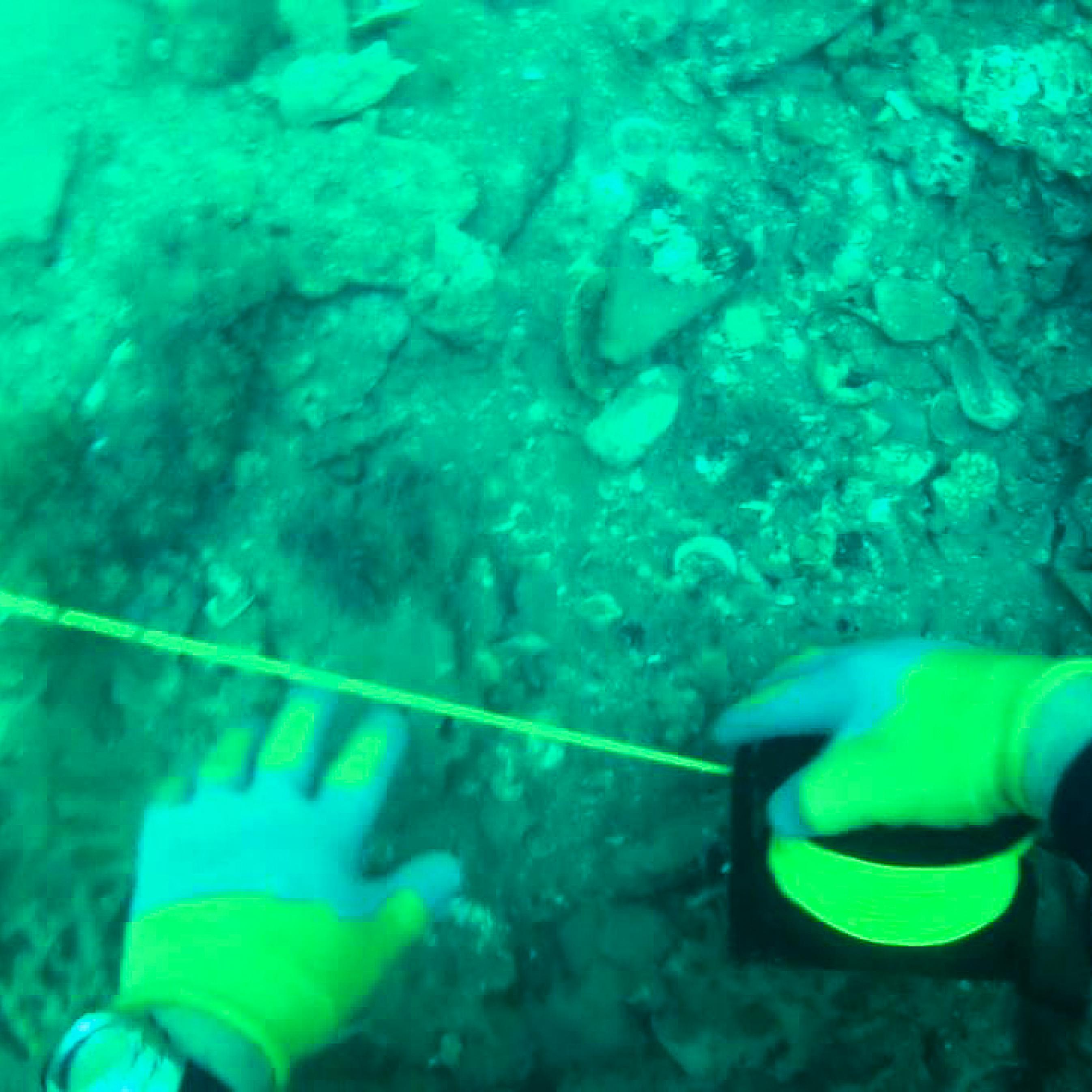
Wilke working underwater
LLA: What's the most exciting thing that's happened to you while diving?
RW: Well, I saw an eight foot shark a few weeks ago while I was alone at 110 feet. It was a Dusky shark, which is an apex predator, and I was kneeling on the bottom, moving sand around looking for teeth. I stopped to check to make sure I had my dive reel still in sight to my left, because you need your reel line to find your way back to the anchor. There, bearing down on me about five feet off the bottom, was this stunning eight foot shark coming straight at me about 20 yards away. It was a sleek fish and, as the visibility that day was excellent, I got an eyeful even at 100+ feet deep. As soon as I straightened up and looked the shark eyeball to eyeball, he turned to the left and swam slowly back the way he came. It wasn’t scary, there wasn't time, it just happened. I credit a guardian angel for making me stop and look to the left or maybe the shark would have taken a bite.
LLA: If THAT wasn't scary, what IS the scariest thing that's happened to you on a dive?
RW: That's pretty easy: either coming close to a panic at 100 feet when I was surprised to be almost out of air and lost, or swimming under a fallen branchy tree in the Meherrin River and not knowing it. When I tried to go up I was held in place by the sunken tree overhead. That was scary.
RW: Well, I saw an eight foot shark a few weeks ago while I was alone at 110 feet. It was a Dusky shark, which is an apex predator, and I was kneeling on the bottom, moving sand around looking for teeth. I stopped to check to make sure I had my dive reel still in sight to my left, because you need your reel line to find your way back to the anchor. There, bearing down on me about five feet off the bottom, was this stunning eight foot shark coming straight at me about 20 yards away. It was a sleek fish and, as the visibility that day was excellent, I got an eyeful even at 100+ feet deep. As soon as I straightened up and looked the shark eyeball to eyeball, he turned to the left and swam slowly back the way he came. It wasn’t scary, there wasn't time, it just happened. I credit a guardian angel for making me stop and look to the left or maybe the shark would have taken a bite.
LLA: If THAT wasn't scary, what IS the scariest thing that's happened to you on a dive?
RW: That's pretty easy: either coming close to a panic at 100 feet when I was surprised to be almost out of air and lost, or swimming under a fallen branchy tree in the Meherrin River and not knowing it. When I tried to go up I was held in place by the sunken tree overhead. That was scary.
LLA: Do you do any land-based fossil hunting or collecting?
RW: I used to, and here in North Carolina there were plenty of places to do it. However just about all of the land base hunting is gone. The Martin Marietta quarries would let you in to hunt around the state but I think that stopped due to safety concerns around 2009.
The End of Summer Auction
Thursday, August 26th
10:00am (EDT)
RW: I used to, and here in North Carolina there were plenty of places to do it. However just about all of the land base hunting is gone. The Martin Marietta quarries would let you in to hunt around the state but I think that stopped due to safety concerns around 2009.
The End of Summer Auction
Thursday, August 26th
10:00am (EDT)


